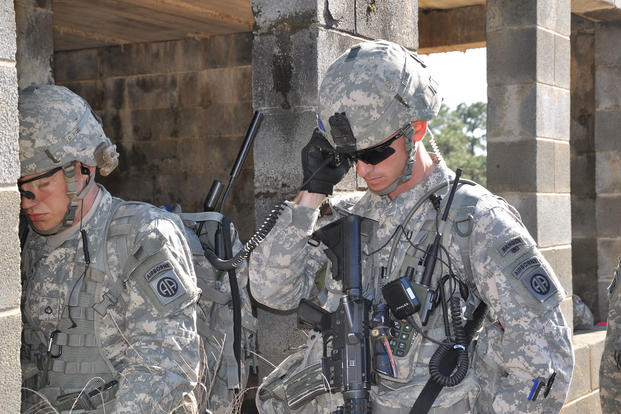U.S. Army tactical radio officials plan to launch a competition for a new handheld radio next year that would give soldiers twice the capability of the current Rifleman Radio.
The Army currently uses the single-channel AN/PRC 154A Rifleman Radio as its soldier handheld data radio. It runs the Soldier Radio Waveform, which small-unit leaders use to download and transmit maps, images and texts to fellow infantry soldiers in a tactical environment.
If they want to talk to each other, they often rely on another single-channel handheld -- the AN/PRC 148 MultiBand Inter/Intra Team Radio, or MBITR, which runs the Single Channel Ground and Airborne Radio, or SINCGARS, for voice communications.
The Army plans to release a request-for-proposal in 2017 for a two-channel radio that will allow soldiers to run the Soldier Radio Waveform, or SRW, for data and SINCGARS for voice on one radio, according to Col. James P. Ross, who runs Project Manager Tactical Radios.
The change will mean that soldiers will no longer need the 148 MBITR and be able to rely on the new, two-channel radio for both data and voice communications, Ross said.
"We know industry can meet our requirements. … We know it's achievable," he said.
The move represents a change in strategy for the Army since the service awarded contracts in 2015 to Harris Corporation and Thales for a next-generation version of the Rifleman Radio.
"We went out with a competition for the next generation of the [Rifleman Radio]. Two companies, Harris and Thales, competed," Ross said. "We went through testing, and we were on the verge of being able to buy more of them when the Army said, 'Our strategy now is two-channel.' "
The Army had planned an initial buy of about 4,000 Thales AN/PRC-154B(V)1 radios and Harris AN/PRC-159(V)1 radios, according to Army program documents for fiscal 2015.
"We will not be taking action on those," Ross said.
The current Rifleman Radio was developed as part of the Handheld, Manpack, Small Form Fit, or HMS program. HMS radios are designed around the Army's tactical network strategy to create secure tactical networks without the logistical nightmare of a tower-based antenna infrastructure.
It's also a key part of the Army's Nett Warrior system. It hooks into an Android-based smartphone and gives soldiers in infantry brigade combat teams the ability to send and receive emails, view maps and watch icons on a digital map that represent the locations of their fellow soldiers. The concept came out of the Army's long-gestating Land Warrior program.
The Army purchased about 21,000 Rifleman Radios under low-rate initial production between 2012 and 2015.
Army officials maintain that are enough single-channel, handheld radios already produced under the low rate initial production that are sitting waiting to be fielded. The service plans to field another two brigade combat teams per year with the single-channel Rifleman Radios through 2019.
The Army will conduct testing of two-channel radios in 2017 and early 2018 and then down-select to one or two vendors sometime in 2018, Ross said. Operational testing is scheduled for 2019 and fielding will begin in 2020 if all goes as planned, he added.
For now, the Army intends to field four BCTs a year with two-channel handheld radios, Ross said.
Small-unit leaders would then be able to retire the MBITR radio from their kit -- a weight savings of about three pounds, according to Army officials at Program Executive Office Soldier.
"One thing the PEO Soldier is very passionate about is weight -- driving that weight down that the soldier carries," said Lt. Col. Derek Bird, product manager for Ground Soldier Systems, which helps oversee the Nett Warrior program.
"If we can cut three pounds off a soldier by taking two radios and shrinking it to one … that is a big deal."
-- Matthew Cox can be reached at matthew.cox@military.com.





























